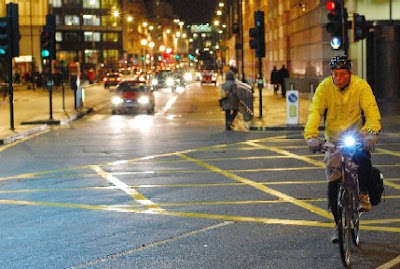
From the Times of London, 02.21.07:
In all the sound and fury about roads in the past few weeks, there can be few groups left that have not had their say, though the arguments of cyclists have quietly glided by. When London’s transport supremos launched the extended congestion charge zone this week, they noted in passing the dramatic increase in cyclists that the capital has seen. In the past five years, the number of people cycling in London has risen by almost 50 per cent. These people are not the mad, bearded loons of popular myth, their coat-tails flapping crazily as they pedal round the Elephant and Castle. The modern cyclist is making an elegant and intelligent response to pollution and traffic congestion.Supportive pro-bicycling commentary by mainstream news outlets is, thankfully, not that unusual anymore. Global climate change, high energy costs, expanding waistlines, pervasive traffic congestion--all are increasingly evident reasons to encourage bicycle commuting. Evident even to journalists.
Cyclist fatalities across the UK rose to three a week last year — the only form of transport to show an increase. Cycle lanes need to be better protected from motorists. There would also be safety in numbers. At 2 per cent ridership, London lags far behind cities such as Berlin (10 per cent), Copenhagen (20 per cent) and Amsterdam (28 per cent), where the cyclist numbers influence driver behaviour. (Read more.)
What I found significant in this article is that it acknowledges the positive effect of "the stick": London's pioneering congestion charge for motorists in the central city has increased the relative attractiveness of the bicycling option. Policy makers in many communities in the U.S. are willing to offer "a carrot" to prospective bicyclists: bike lanes, secure bike racks, intermodal access. However, these same policy makers are reluctant to introduce any politically challenging "stick" (higher parking fees, speed reduction, traffic restrictions, road diets, etc.) that proactively discourages motorists. The balance of street conditions still heavily favors automobiles. Shifting that balance to encourage bicycling and walking will require not simply a few "carrots," but some "sticks."
The other significant point in this article is the recognition that increased presence of bicyclists and pedestrians is, in itself a traffic calming effect. (Thanks to Peter Jacobsen of Sacramento for his great research on this.)
("Mad, bearded loons"?!? Maybe we're not fully there with the mainstream media.)
Image: Web capture.
Visit: Paul Dorn's Bike Commuting Tips Site


No comments:
Post a Comment